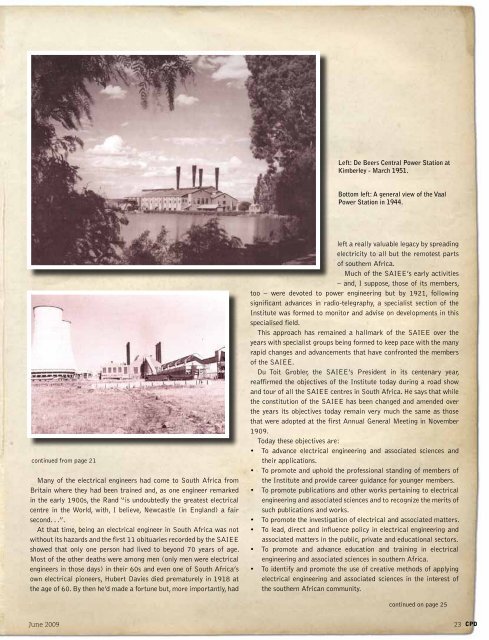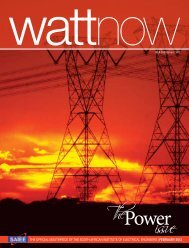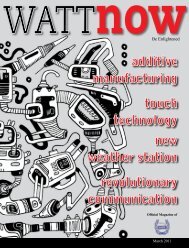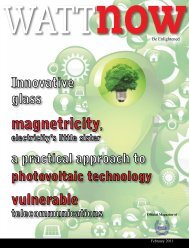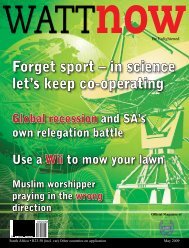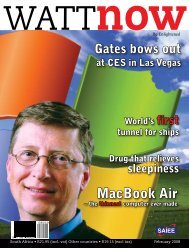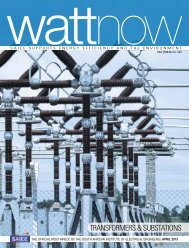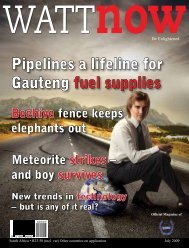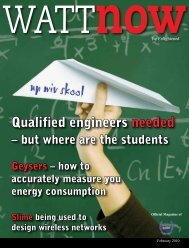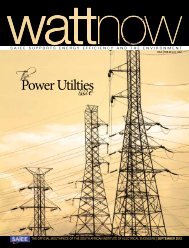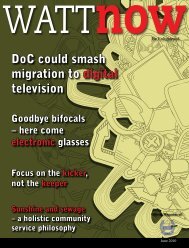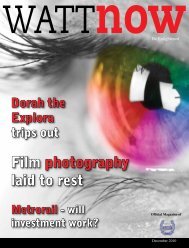download a PDF of the full June 2009 issue - Watt Now Magazine
download a PDF of the full June 2009 issue - Watt Now Magazine
download a PDF of the full June 2009 issue - Watt Now Magazine
- No tags were found...
Create successful ePaper yourself
Turn your PDF publications into a flip-book with our unique Google optimized e-Paper software.
Left: De Beers Central Power Station atKimberley - March 1951.Bottom left: A general view <strong>of</strong> <strong>the</strong> VaalPower Station in 1944.continued from page 21Many <strong>of</strong> <strong>the</strong> electrical engineers had come to South Africa fromBritain where <strong>the</strong>y had been trained and, as one engineer remarkedin <strong>the</strong> early 1900s, <strong>the</strong> Rand “is undoubtedly <strong>the</strong> greatest electricalcentre in <strong>the</strong> World, with, I believe, Newcastle (in England) a fairsecond. . .”.At that time, being an electrical engineer in South Africa was notwithout its hazards and <strong>the</strong> first 11 obituaries recorded by <strong>the</strong> SAIEEshowed that only one person had lived to beyond 70 years <strong>of</strong> age.Most <strong>of</strong> <strong>the</strong> o<strong>the</strong>r deaths were among men (only men were electricalengineers in those days) in <strong>the</strong>ir 60s and even one <strong>of</strong> South Africa’sown electrical pioneers, Hubert Davies died prematurely in 1918 at<strong>the</strong> age <strong>of</strong> 60. By <strong>the</strong>n he’d made a fortune but, more importantly, hadleft a really valuable legacy by spreadingelectricity to all but <strong>the</strong> remotest parts<strong>of</strong> sou<strong>the</strong>rn Africa.Much <strong>of</strong> <strong>the</strong> SAIEE’s early activities– and, I suppose, those <strong>of</strong> its members,too – were devoted to power engineering but by 1921, followingsignificant advances in radio-telegraphy, a specialist section <strong>of</strong> <strong>the</strong>Institute was formed to monitor and advise on developments in thisspecialised field.This approach has remained a hallmark <strong>of</strong> <strong>the</strong> SAIEE over <strong>the</strong>years with specialist groups being formed to keep pace with <strong>the</strong> manyrapid changes and advancements that have confronted <strong>the</strong> members<strong>of</strong> <strong>the</strong> SAIEE.Du Toit Grobler, <strong>the</strong> SAIEE’s President in its centenary year,reaffirmed <strong>the</strong> objectives <strong>of</strong> <strong>the</strong> Institute today during a road showand tour <strong>of</strong> all <strong>the</strong> SAIEE centres in South Africa. He says that while<strong>the</strong> constitution <strong>of</strong> <strong>the</strong> SAIEE has been changed and amended over<strong>the</strong> years its objectives today remain very much <strong>the</strong> same as thosethat were adopted at <strong>the</strong> first Annual General Meeting in November1909.Today <strong>the</strong>se objectives are:• To advance electrical engineering and associated sciences and<strong>the</strong>ir applications.• To promote and uphold <strong>the</strong> pr<strong>of</strong>essional standing <strong>of</strong> members <strong>of</strong><strong>the</strong> Institute and provide career guidance for younger members.• To promote publications and o<strong>the</strong>r works pertaining to electricalengineering and associated sciences and to recognize <strong>the</strong> merits <strong>of</strong>such publications and works.• To promote <strong>the</strong> investigation <strong>of</strong> electrical and associated matters.• To lead, direct and influence policy in electrical engineering andassociated matters in <strong>the</strong> public, private and educational sectors.• To promote and advance education and training in electricalengineering and associated sciences in sou<strong>the</strong>rn Africa.• To identify and promote <strong>the</strong> use <strong>of</strong> creative methods <strong>of</strong> applyingelectrical engineering and associated sciences in <strong>the</strong> interest <strong>of</strong><strong>the</strong> sou<strong>the</strong>rn African community.continued on page 25<strong>June</strong> <strong>2009</strong> 23


